After fighting off a rather irritating chest infection that stopped me from diving for a while I gradually started getting back in the water and immediately began preparing for a new adventure, this time a bit closer to home. I loaned some parts from Anders at Oxygene in Gothenburg so I forced my friends to go diving with me to try them out and get back in the game before my next adventure.
When I tell people I live in Sweden they usually make the association that it is very far to the north but in truth I live in the southern parts of Sweden at only about 57 degrees north. This trip sent me straight north to a very special area close to Strömsund in northern Jämtland at about 65 degrees north. By the little village Stora Blåsjön (the Great Blue Lake) is an area of limestone that has given the area a very special look and a varied flora not seen in other parts of Sweden. It is also an area with a number of caves formed by the water flowing through the cracks in the mountains. The longest dry cave in Sweden, the Coral cave, can be found here but it is also the site of potentially one of the world´s most ambitious ongoing cave diving explorations. As the river Bjurälven enters Sweden from Norway it soon disappears underground and is gone from view for about three kilometers before reappearing downstream again. Speleologists have been interested in the area for a long time but haven’t had the means to enter the water filled passages, but with the ongoing project Expedition Bjurälven this has changed. The first dives when it was established the cave in the little lake Dolinsjön could be used as an entrance to the system was made in 2007 and since then there has been at least a week of exploration each year except for one. Actually the cave was found much earlier than this in 1979 when Bo Lenander donned a mask and freedived down in the chilly mountain lake to find a cave that he deemed was big enough to squeeze into. Without dive gear and faced with a big water flow he wisely didn’t at that time.
The expedition is held by the Swedish Speleological Society’s Diving Section and participation is by invitation only. So what makes this expedition such a special one? Well there are many things. For one the diving is only conducted in wintertime when the lake is covered by over a meter of ice and then a considerable amount of snow on top of that and with air temperatures going as low as -20 C or beyond. Why, you ask? Is it the crazy Swedes trying to stay true to their Viking heritage?
No, this cave is very much an active cave still being formed and the thing carving it out of the rock is flowing water, lots of flowing water. As the spring comes and the snow on the mountains melts the flow can be up to 20 knots coming out of the cave and this very effectively stops any diver from going in. But in the winter time the flow is next to zero and although cold, the diving gets easier.
The cave is also very remote, first it is a trip of about 15 hours by car north (make that 23 hours with public transport and 60kgs of gear) then it is repacking to snowmobiles and driving for about 40 minutes out into a nature reserve to the dive site. The expedition holds special permission for the diving and for transporting gear as this is a protected area because of the very special nature. So after getting that far, a hole is made in the thick ice and a base camp is set up. The organization is astonishing and by experience the members know what to bring. There are heated tents for changing and a transportable power generator for making coffee and hot food. To keep warm is extremely important out here and a lot of thought has gone into this subject.
What about the diving then? Surely after this much ordeal the diving is simple? Oh no my friend, the fun has just begun. Upon entering the water, which is about 1 C, you quickly need to drop down so as not to get a frozen regulator at the surface that starts free flowing, wasting your gas and postponing the dive. Then the entrance to the cave needs to be dug out at the beginning of the week so a diver with side mount can squeeze through. The first time I did this I swam back and forth a few times to get used to the restriction and it actually felt better by each passing. Still, people get stuck here quite often and you need to stay calm and dig yourself free. Well inside, the passage is low but stunningly beautiful, the white walls are faceted after being carved by the water and looks like they are made of snow. We had planned a shorter acclimatizing dive as my first one but it held enough surprises. After facing another creep and crawl restriction that made me happy for the helmet I had borrowed my first regulator began to flow, I shut it down and went on to the next one for a few breaths before that one froze as well… this being such a common problem up here every diver actually carries at least three tanks each so I switched to my third regulator only to be faced with a third freeze… happy days. Thinking about my options I started breathing from the reg that was worst of, a really full on freeze and by opening and closing the valve for each breath, I could conserve the air in the tank. I signaled my buddies it was time to go and we turned to swim out. On the way I checked the other two regulators and they had thawed somewhat and had stopped flowing so I could keep them open, still breathing from the tank that was worst of. As we went through the last restriction I breathed from one of the working regulators as valve handling and squeezing would be a bit tricky. As I calmly swam out of the cave I sent a thought to Cristina who had taught me the importance of keeping cool in the cave at all times and a situation that might have been uncomfortable now seemed more like a good experience. After this first dive I had no problems with any regulator for the rest of the trip so I figure maybe this was the caves way of welcoming me and at the same time reminding me to keep being alert.
On later dives I went further into the cave and came to places like the altar hill and the temple room that are absolutely breathtaking places and has only been visited by a handful of people over the last few years. The high flow in the cave makes wonderful formations and very clean white walls that reflect your light right back at you. I also met with some of the sluggish trout living in the cave, it seems like they have no idea how to react to a diver visiting so they just stay there and stare at you even when you are just centimeters away. Some of the fish has been collected for research and could even be collected by hand in some cases.
I was prepared for the cold water and was a bit surprised that even after an hour in the freezing water I wasn’t really cold. But with a Fourth Element SubX undergarment and a Whites Fusion Tech drysuit I really shouldn’t be surprised. As I said, keeping warm is the top priority both for comfort and to keep alert. A cold and sluggish diver makes mistakes so proper insulation is an important part of diving in challenging conditions.
The project aims to explore the cave that has become the longest underwater cave in Sweden and is adding more line daily and surveying every meter of it. Every 2,5 meters the direction, depth and volume of the cave is recorded and all the data is then entered in a computer to get a 3D picture of the cave. To help with accurate mapping is a system for tracking the divers underground. It is Bo that 33 years after finding the cave still is very much involved in exploring it. He is not only an active spelunker but also a top radio amateur that custom builds the tools used for this tracking. Certain points in the cave is marked and topside is tracked and then measured with high precision GPS so the positions of the divers can be determined with astounding precision. When two divers found a dry section of cave several hundred meters back they could come back the next day with another of Bo´s inventions, a through rock cave phone so they could let the surface support know they were alright and walked around in the cave beyond. With this kind of teamwork and advanced technical aids the mapped passages now measure over 900 meters and with the current rate I think its safe to say next year it will extend well beyond a kilometer.
All things taken together with the effective teamwork establishing base camp, having advanced tracking technique and performing exploration dives at difficult subzero conditions makes this project an impressive and really inspiring one. It would never be possible without the help of sponsors, both local and international, but the people that really deserve recognition is the local inhabitants that help the expedition year after year.
A special thanks to Micke Tilja from Dykarna.nu for many of the pictures.
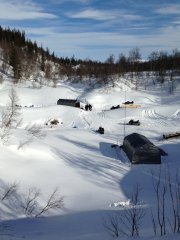
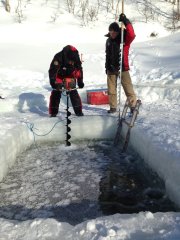
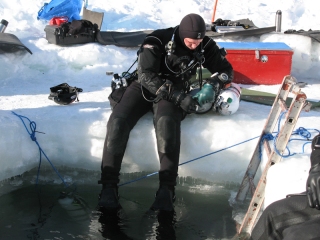
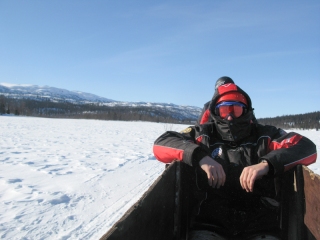
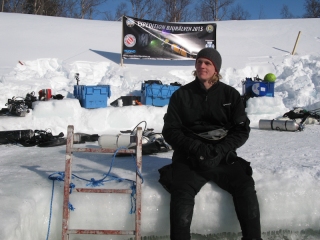
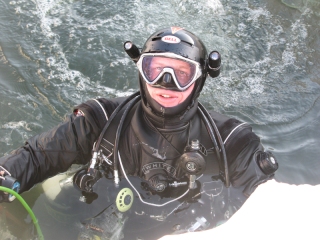
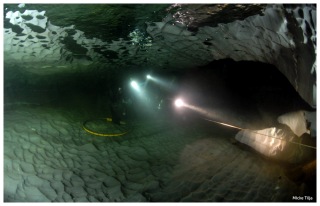
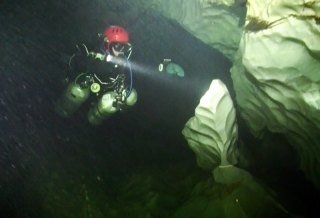
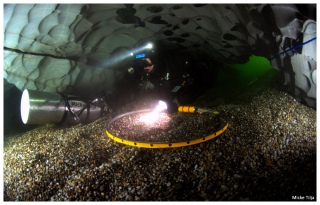
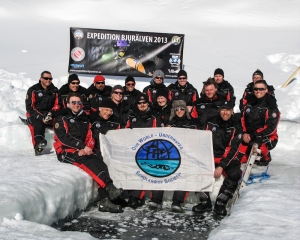















Loved reading your report and your experience, amazing in all aspects of it, from logistics to landscapes. Congratulations on your performance.